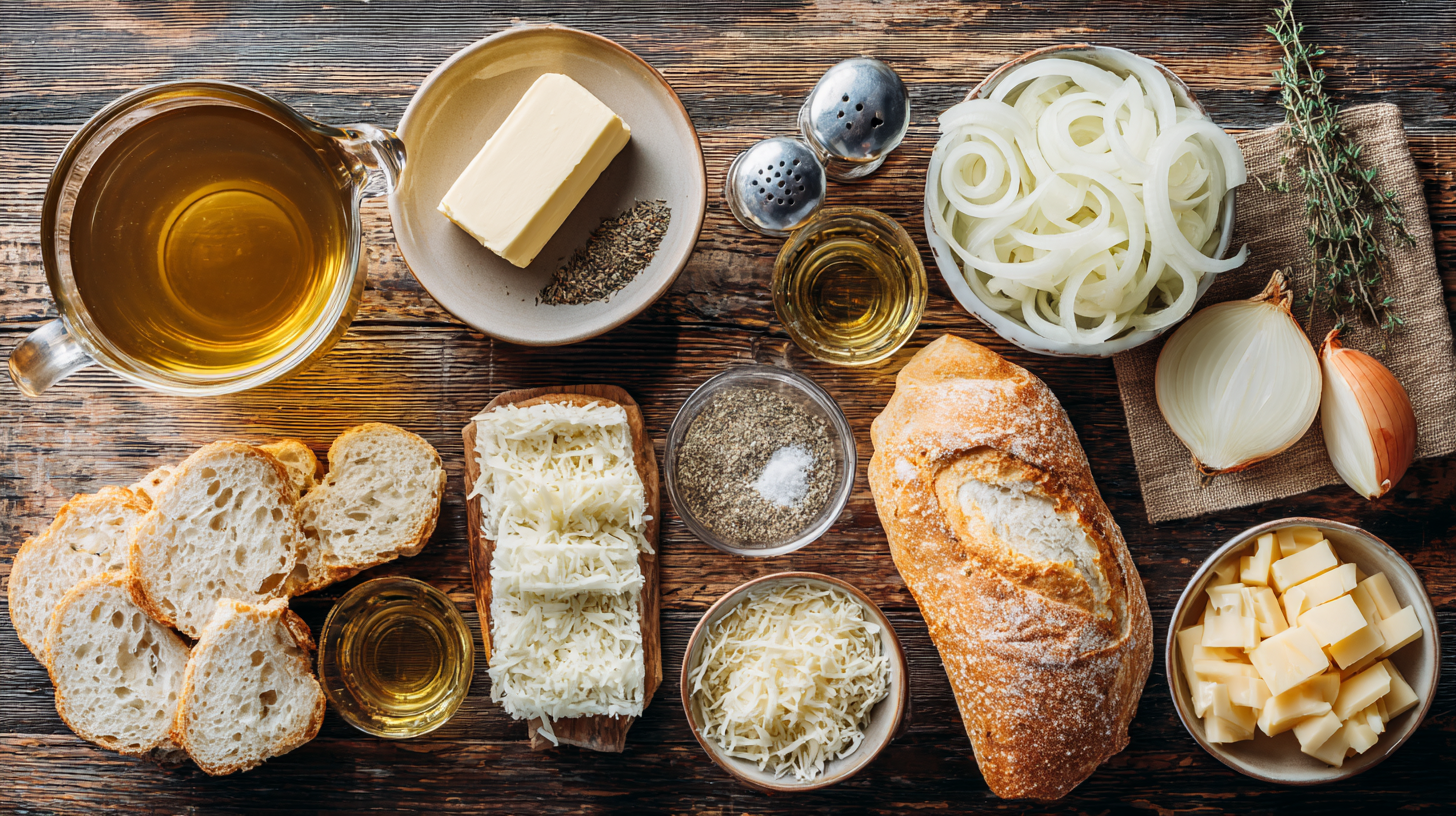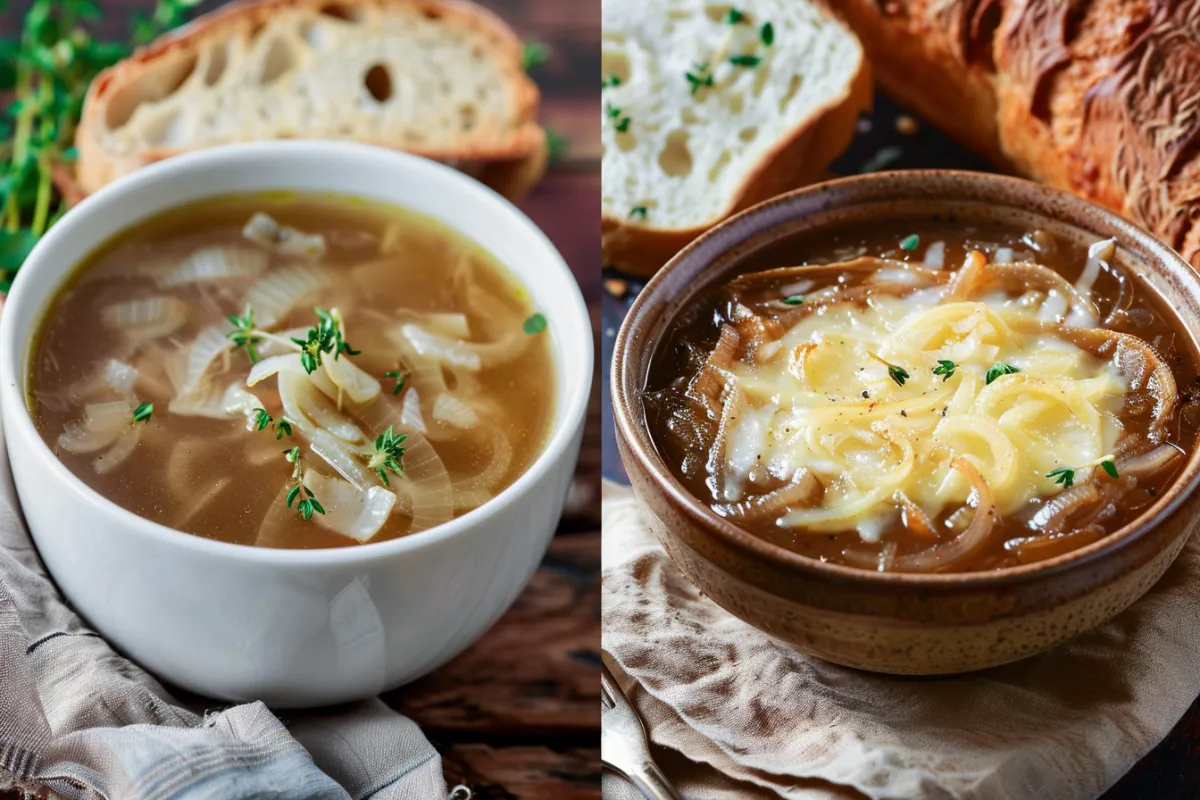When it comes to comfort food, few things can beat a warm, savory bowl of onion soup. But have you ever wondered what the difference is between onion soup and French onion soup? While both are delicious and onion-forward, they each bring unique flavors, ingredients, and preparation methods to the table. This article will break down the key differences between the two, helping you understand what makes each one special.
Let’s dive in and explore the history, ingredients, and unique characteristics that set the first soup apart from the much-loved the second soup.
What is Onion Soup?
Onion soup is a broad category of soup that features onions as the main ingredient. While onion soup varies widely depending on the region, culture, or recipe, its fundamental ingredients include onions, broth, and basic seasonings.
Basic Ingredients of Onion Soup
The typical ingredients you’ll find in a standard soup include:
- Sliced onions (yellow, white, or a combination)
- Chicken, vegetable, or beef broth
- Butter or oil for sautéing the onions
- Seasonings like salt, pepper, and herbs (such as thyme or bay leaves)
- Optional toppings like croutons or a sprinkling of cheese
How Onion Soup is Made
The onions in this soup are usually sautéed or lightly caramelized before adding broth and seasonings. Depending on the recipe, some soups are finished with bread or croutons, but without the elaborate cheese topping typical of French onion soup.
Serving Styles
Onion soup is often served with croutons or bread on the side for dipping. The soup itself can range from light and brothy to more substantial versions that incorporate other vegetables or even meat.
What is French Onion Soup?
This soup is a traditional French dish that has become iconic worldwide. It’s richer and heartier than generic onion soup, with a depth of flavor that comes from slowly caramelizing the onions and using beef broth as the base.
Key Ingredients of French Onion Soup
The key ingredients of this soup include:
- Caramelized yellow or white onions
- Rich beef broth
- A splash of white or red wine (optional, but often used)
- Fresh herbs like thyme and bay leaves
- Gruyère or Comté cheese
- Thick slices of toasted French baguette
How French Onion Soup is Made
To make this soup, the onions are cooked slowly over low heat until they caramelize, giving the soup its signature sweetness and complexity. After deglazing the pan with wine, beef broth is added, and the soup simmers until all the flavors meld together. The final step is assembling the soup in oven-safe bowls, topping each serving with a slice of toasted baguette and plenty of grated Gruyère cheese, and broiling until the cheese is golden and bubbly.

Traditional Serving Style
French onion soup is traditionally served piping hot with the bread and melted cheese topping. The rich flavors of the soup combined with the cheesy bread make this dish a meal in itself, especially during the colder months.
Historical Background
Understanding the difference between the first soup and the second soup involves looking at their origins. Both soups have long histories but evolved in different culinary traditions.
The Origins of Onion Soup
This soup has ancient origins, dating back to Roman times. Onions have long been a staple in soups due to their availability and affordability. Many cultures around the world have their versions of this soup, from the simple brothy English onion soup to heartier, more flavorful interpretations like those in Germany and Japan.
The History of French Onion Soup
This soup began as a humble dish enjoyed by French peasants, but it has since become a fine dining staple. Its transformation is attributed to the French culinary tradition of using simple, inexpensive ingredients (like onions) and elevating them through technique—namely caramelization and the use of high-quality beef broth and cheese. The dish became popular in Paris during the 18th century and has since spread worldwide.
Key Differences
Now that we understand the background of these soups, let’s break down the main differences between the first soup and the second soup.
Ingredients
- The first Soup: This can be made with a variety of broths—chicken broth, vegetable broth, or beef broth. It doesn’t always call for cheese or wine and is often served without a bread topping.
- The second Soup: Uses caramelized onions, beef broth, and is typically deglazed with wine. Gruyère or Comté cheese is an essential ingredient, and it’s topped with a slice of toasted baguette.
Broth
- The first Soup: Broth choice can vary—light chicken or vegetable broths are often used, which results in a lighter flavor.
- The second Soup: Always uses a beef broth base, which gives the soup a deeper, more savory flavor.
Onions
- The first Soup: The onions are usually sautéed or lightly caramelized but not cooked as long as in French onion soup.
- The second Soup: The onions are slowly caramelized until they become deeply browned, sweet, and full of flavor, which is essential to the soup’s rich taste.
Cheese
- The first Soup: Cheese is optional and is often sprinkled lightly, if at all.
- The second Soup: Gruyère or Comté cheese is a must, melted and broiled over the soup to form a golden, bubbly crust.
Preparation and Cooking Techniques
- The first Soup: Often quicker to make, with simpler preparation techniques. The onions are cooked until tender, and the soup can be made in a single pot.
- The second Soup: Requires more time due to the slow caramelization process and the final step of broiling the cheese-topped soup in the oven.
Flavor Profiles
- The first Soup: Lighter, with a more delicate onion flavor, especially when made with chicken or vegetable broth.
- The second Soup: Richer, with deep umami flavors from the beef broth, caramelized onions, and melted cheese.
Global Variations of Onion Soup
While the second soup is the most well-known, there are many other variations of the first soup around the world. Each region brings its own twist to this classic dish.
English
English onion soup is often lighter and more herb-forward, with fresh herbs like parsley and thyme. It’s usually served with a slice of bread but lacks the cheese topping that defines French onion soup.
American
In the U.S., onion soup is often simplified. It’s made with chicken broth or vegetable broth, and some versions even use the first soup mix for a quicker, easier meal. While it can be hearty, it doesn’t typically have the same rich flavor profile as the second soup.
Japanese
Japanese onion soup is lighter and often features miso or soy sauce as the base. It’s typically served as a starter in Japanese restaurants, offering a delicate and umami-packed broth without the heaviness of cheese or bread.
German
German versions often include added meats, like sausage or bacon, and rye bread instead of the traditional French baguette. It’s heartier and more rustic, reflecting the flavors of German cuisine.
French Onion Soup in Fine Dining and Popular Culture
Over the years, French onion soup has become a symbol of French culinary expertise, moving from a humble peasant dish to a staple in fine dining.
French Onion Soup in Fine Dining
Many fine-dining restaurants elevate French onion soup by using gourmet ingredients, such as premium beef broth, vintage Gruyère, and artisan bread. In these settings, the soup is carefully prepared to create a delicate balance of flavors, often with the addition of truffles, aged wine, or special herbs.
Popular Culture
French onion soup has made appearances in movies, TV shows, and even celebrity cookbooks, becoming a global favorite. Whether it’s being served in a quaint French bistro or a Michelin-starred restaurant, this dish continues to captivate food lovers around the world.
Health and Nutritional
When comparing the first soup and the second soup, there are notable differences in their nutritional profiles.
Calories and Fat
- Onion Soup: Typically lower in calories and fat, especially if made with vegetable or chicken broth and without cheese or heavy cream.
- French Onion Soup: Higher in calories and fat due to the use of beef broth, butter, and melted cheese.
Sodium Levels
Both soups can be high in sodium, particularly if using store-bought broth. However, French onion soup tends to have more sodium due to the addition of cheese and salted butter.
Nutritional Benefits of Onions
Both soups provide the health benefits of onions, which are rich in antioxidants, vitamins, and anti-inflammatory properties.
Tips for Making the Best Soup at Home
Whether you’re making the first soup or the second soup, here are some tips to get the most flavor out of your dish.
For Onion Soup
- Choose the right onions: Yellow or white onions work best for a sweet yet savory flavor.
- Use high-quality broth: Opt for homemade or low-sodium broth to control the flavor.
- Enhance with herbs: Fresh thyme, parsley, or bay leaves add depth and freshness.
For French Onion Soup
- Caramelize slowly: Take your time caramelizing the onions—this is the key to a great French onion soup.
- Use wine for deglazing: A splash of white or red wine adds complexity to the soup.
- Choose the right cheese: Gruyère or Comté cheese is ideal for that rich, golden topping.
Reader-Approved French Onion Soup Recipes from Top Websites
If you’re ready to try making the first soup or the second soup at home, here are some popular recipes to get you started:
- The Clean Eating Couple’s Easy French Soup: A healthier take with fewer calories but all the flavor.
- Once Upon a Chef’s French Soup: Traditional recipe with detailed tips for perfect results.
- Dishes and Dust Bunnies’ Classic French Soup: Family-friendly and easy to follow.
FAQs
What pairs well with French onion soup?
This soup pairs well with light salads, roasted vegetables, or crusty bread to balance the rich, savory flavors of the soup.
How do you deepen the flavor of French onion soup?
To deepen the flavor of this soup, caramelize the onions slowly to bring out their natural sweetness, use high-quality beef broth, and deglaze the pan with wine or brandy for added richness.
Conclusion:
While both onion soup and French onion soup share a base of onions and broth, the differences between them make each one unique. the first soup offers a lighter, simpler experience, while the second soup delivers deep, complex flavors with its caramelized onions, beef broth, and melted cheese topping.
Whether you prefer the rustic appeal of a traditional soup or the indulgence of a cheesy, savory soup, both bring comfort and warmth to the table. Try them both and find your favorite!

